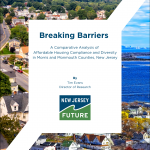New Jersey Future Blog
Promoting Integration at the Local Level
July 20th, 2023 by Tim Evans
While New Jersey is one of the most diverse states in the nation at the macro level, at the local level it is also one of the most segregated. The state has grown more demographically diverse over the last two decades, but most of its individual towns and neighborhoods are either predominantly white or predominantly non-white, with few places occupying the “diverse” range in between. What can leaders do to promote more stable integration, so that towns can remain in the “diverse” space for the long term, rather than just momentarily passing through as part of a transition from one extreme to another?
Panelists in the session on “Promoting Integration at the Local Level” at the 2023 Planning and Redevelopment Conference offered insights to promoting diversity at the municipal level. Jessica Rafeh, Committeewoman and former Mayor of Pennsauken Township; Michele Alonso, Director of Planning and Redevelopment for the City of Asbury Park; and the session’s moderator, Nancy Gagnier, the Executive Director of the South Orange/Maplewood Community Coalition on Race talked about their experiences at the local level, while Jeffrey Perlman, Senior Director of Planning at the North Jersey Transportation Planning Authority (NJTPA), provided a regional perspective.

The virtual session Promoting Integration at the Local Level at the 2023 NJ Planning and Redevelopment Conference. Top row from left to right: Nancy Gagnier, Executive Director, South Orange/Maplewood Community Coalition on Race; Michele Alonso, Director of Planning and Redevelopment, City of Asbury Park. Bottom row from left to right: Jessica Rafeh, Committeewoman and former Mayor, Pennsauken Township; Jeffrey Perlman, Senior Director of Planning, North Jersey Transportation Planning Authority (NJTPA).
At the local level, a big part of promoting economic diversity means making sure there are housing options for households of all income levels, which requires local zoning that permits a diversity of housing types. Rafeh specifically mentioned Pennsauken’s broad range of housing types, and that the township is one of the rare suburban towns that already exceeds its Mount Laurel obligation for lower-income units. Alonso talked about the benefits of inclusionary zoning ordinances, noting that Asbury Park’s ordinances require new developments to be 20% affordable to be eligible for density bonuses. She also pointed out that redevelopment plans negotiated with developers offer an opportunity for towns to encourage a range of housing options: “Redevelopment agreements are an important tool that towns can use to make sure new developments are as economically inclusive as possible.”
Gagnier described South Orange/Maplewood’s first-time homebuyers loan program that is targeted at racial minorities to help them move into town, or to help existing renters graduate to homeownership. “Towns need to pay attention to changing demographics if they want to foster or preserve integration, so they can take steps to stay ahead of the changes,” she said. Achieving stable integration means towns must stay engaged as development patterns and housing markets change.
As a counterpart to programs and policies designed to help new residents move in, local leaders can also take steps to allow existing residents to stay in town when revitalization puts upward pressure on home prices, so that towns don’t become “victims of their own success” (a term cited by both Gagnier and Alonso as being a concern in their towns). Alonso said that Asbury Park recently adopted rent control as a way to guard against displacement of long-time residents, allowing them to participate in the benefits of revitalization when it happens. For homeowners, both Rafeh and Gagnier talked about local programs to help people finance home repairs.
Gagnier observed that while the percent of New Jersey’s population living in mixed-race neighborhoods has gone up in recent decades, “we still in many ways experience our lives in what feel like separate, segregated existences.” Maintaining good public spaces is one technique local officials can undertake to ensure mixed-race and mixed-income neighborhoods actually result in a feeling of diversity and belonging, with programmed public events that encourage people of different backgrounds to interact. Rafeh said she was excited about the construction of a new community center in Pennsauken intended to host such events. Over the longer term, Rafeh also mentioned the importance of representation on governing bodies in making people from diverse backgrounds feel included.
Perlman offered perspective about higher levels of government, saying that the NJTPA pays attention to changing demographics because they may mean changing demand for transportation services, and the organization needs to adapt. NJTPA’s Plan 2050 cites regional equity as one of the organization’s planning objectives, and NJTPA also must determine how to advance the federal Justice40 initiative, which requires that transportation funding must prioritize disadvantaged communities that have suffered in the past from a lack of transportation investments, or that have borne the brunt of the negative effects of past transportation projects. NJTPA will thus be seeking to take active steps to promote stable racial and economic integration, like aligning transportation investments with the state’s affordable housing policies and integrating housing needs into its long-range planning.
At the state level, Gagnier suggested that the school funding formula could provide more funding to diverse districts as a way of promoting integration. Rafeh said other state funds could provide more local assistance to towns that are trying to promote stable integration, via programs like home loan assistance or small business startup loans, since new businesses are often started by residents from demographic groups that are new to town.
For more about what local leaders can do to promote integration, see Promoting and Maintaining Racial Integration: Lessons from Selected New Jersey Towns, by New Jersey Future intern Isabel Yip, which served as the inspiration for this session and for which several of the panelists were also interviewed.
Related Posts
Tags: Demographics, Housing, housing and equity, integration, Local Planning, Redevelopment, regional planning, revitalization, segregation, Transportation
















